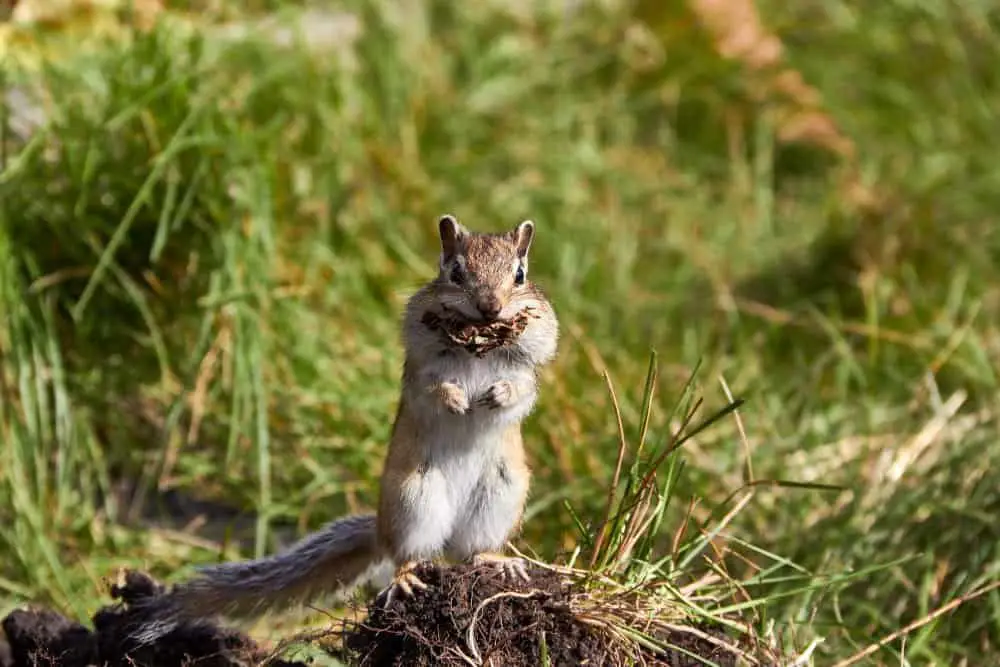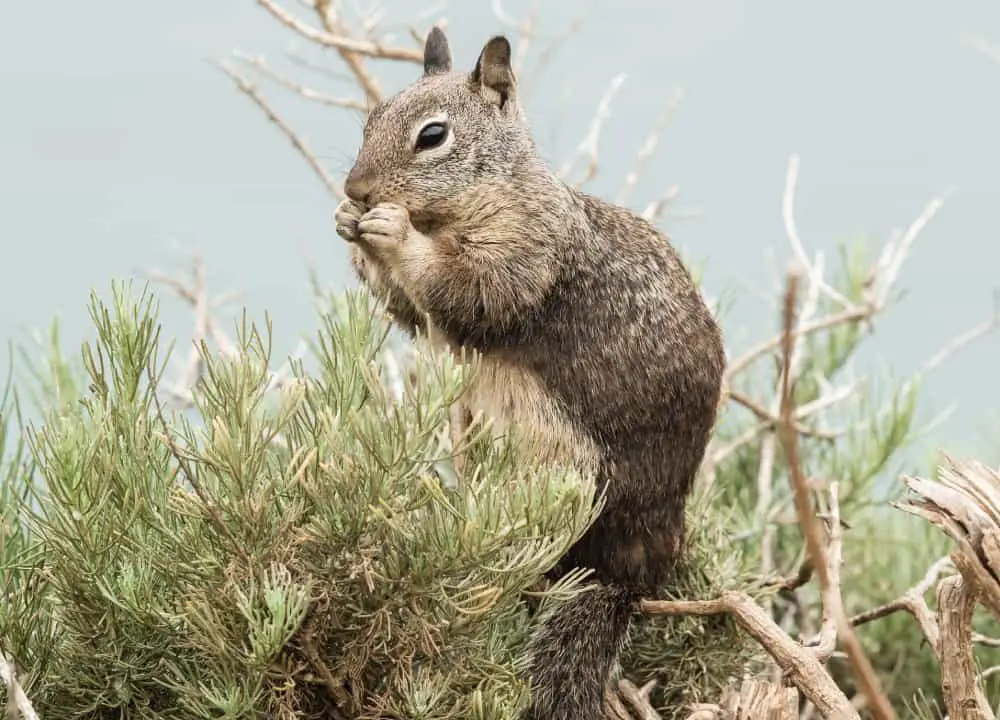If you’ve ever noticed a sudden disappearance of pine cones in your yard, you may be dealing with squirrely culprits. Squirrels are known to be quite fond of pine cones, particularly for the seeds located in between the scales.
As charming as these furry creatures can be, their pine cone feasting can become a nuisance and may even damage trees in your landscape. Don’t worry, though; there are humane and effective ways to keep your pine cones safe.
In this article, we will explore various tips and techniques to stop squirrels from eating pine cones in a way that is environmentally friendly and safe for both your greenery and the squirrels themselves.
With a little diligence, you can maintain a beautiful landscape and keep these critters at bay.
Understanding Squirrel Behavior
Squirrel Diet and Nutrition
Squirrels are creatures of nature, mainly feeding on seeds, nuts, and fruits. The red squirrel, in particular, is known for its fondness for pine cones. Pine cones provide these squirrels with a rich source of nutrition, as the seeds inside the cones have a high-protein content. This diet helps them maintain their energy levels, as well as grow healthy fur and teeth.
Squirrel Habits and Foraging Strategies
When it comes to foraging, red squirrels are quite strategic. In search of pine cones, they gather around pine trees, where they frequently find their favorite food. They chew on the outer scales of the cones to get to the seeds inside.
During the winter months, squirrels tend to bury the food that they’ve gathered. Burying the pine cones helps the squirrels ensure that they have a food source when it becomes scarce. Furthermore, their sharp memory enables them to find and retrieve these hidden treasures with ease.
Types of Squirrels and Their Habitats
American Red Squirrels
American red squirrels (Tamiasciurus hudsonicus) are small, bushy-tailed rodents found throughout Alaska, Canada, and parts of the United States. They primarily inhabit conifer forests with plenty of evergreen trees, where they build their nests and forage for food.
These squirrels belong to the Sciuridae family and are known for their reddish-brown fur and distinctive eye rings.
As omnivores, American red squirrels have a diverse diet consisting of:
- Seeds and nuts, particularly pine cones
- Fungi
- Insects
- Bird eggs
Ground Squirrels
Ground squirrels include several species that dwell on or under the ground. Despite their name, they are actually closer in appearance and behavior to chipmunks than tree squirrels. These squirrels inhabit diverse environments, ranging from open grasslands to rocky areas. Some of the species, like the thirteen-lined ground squirrel, also live in suburban and city areas.
Ground squirrels are mainly herbivores and consume:
- Grasses
- Forbs
- Fruits
- Seeds
They also occasionally eat insects and other small invertebrates.
Tree Squirrels
Tree squirrels are the largest group within the squirrel family. These energetic critters are known for their agile climbing and leaping abilities, sizeable bushy tails, and preference for living in trees. Tree squirrels can be found in various habitats, such as hardwood forests, mixed woodlands, and parks.
Some common species of tree squirrels include:
- Eastern gray squirrel
- Western gray squirrel
- Fox squirrel
While tree squirrels tend to be omnivorous, their primary food source is plant-based, including:
- Nuts
- Seeds
- Fruits
- Bark and twigs
Pine Cone Basics
Pine Cone Anatomy
Pine cones are the reproductive structures of conifer trees. They contain seeds that are essential for the propagation and survival of these trees. Pine cones come in various sizes and shapes, depending on the species of the conifer tree. There are two types of pine cones: male pine cones and female pine cones.
The male cones release pollen, while the female cones hold the seeds. When mature, female pine cones open up, allowing the seeds to be dispersed by the wind or by animals.
Nutritional Value of Pine Cones and Seeds
Conifer seeds, such as pine seeds, are packed with nutrients that benefit both animals and humans. Some of the essential nutrients found in these seeds include:
- Proteins: These are essential building blocks for muscles, skin, and other bodily tissues.
- Carbohydrates: As a good source of energy, carbohydrates are crucial for maintaining energy levels.
- Fats: Fats provide long-term energy sources and aid in nutrient absorption.
In addition to these macronutrients, conifer seeds also contain several vitamins and minerals that contribute to their high nutritional value. Some prominent ones include:
| Nutrient | Importance |
|---|---|
| Potassium | Helps in regulating blood pressure and fluid balance |
| Phosphorus | Supports bone and teeth health |
| Manganese | Essential for metabolism and antioxidant systems |
| Zinc | Supports immune system and wound healing |
| Vitamin K | Aids in blood clotting and bone health |
When it comes to consuming pine cones, green pine cones are typically avoided as they can be tough and bitter. However, animals like rabbits can gnaw on the green pine cones due to their strong front teeth, which allow them to break down the tough plant material.
While animals like squirrels are attracted to the seeds within the pine cones, they might also consume some of the plant material in the process.
Deterring Squirrels from Pine Trees

Using Physical Barriers
One effective way to keep squirrels from eating pine cones is by installing physical barriers. A fence made of chicken wire can be placed around the base of the tree to prevent the squirrels from climbing. Additionally, attaching a sheet metal collar around the trunk, about 6 feet above the ground, can make it difficult for squirrels to climb up the tree.
Applying Repellents
Another strategy for deterring squirrels is applying repellents, such as hot sauce or cayenne pepper, to the pine cones. These ingredients contain capsaicin, which irritates the squirrels and deters them from eating the pine cones. To further discourage squirrels, consider using predator urine around the base of the tree.
However, consult with a wildlife expert before using predator urine, as it can also affect other animals like honeybees and acorn woodpeckers.
| Repellent | Effective Usage |
|---|---|
| Hot Sauce | Apply to pine cones |
| Cayenne Pepper | Sprinkle around tree base |
| Predator Urine | Outskirts of the tree area |
Alternative Food Sources
Providing alternative sources of food for the squirrels in your garden can help distract them from your pine cones. For instance, installing a separate bird seed feeder or planting nut trees like pecan or walnut trees can keep those tiny paws occupied with other things.
When planting these alternative food sources, make sure they are positioned far enough from the pine trees to lead the squirrels away – ideally on the opposite side of your garden.
To recap:
- Use physical barriers such as chicken wire fence and sheet metal
- Apply repellents like hot sauce, cayenne pepper, and predator urine
- Provide alternative food sources: bird seed feeders or nut trees
Protecting Other Garden Plants and Wildlife
Protecting Bulbs and Roots
As a nature lover, you may want to make sure your garden remains a haven for both plant life and wildlife. One way to do this is by protecting bulbs and roots from squirrels. Here are some practical tips to achieve this:
- Wrap bulbs in metal mesh or plastic netting to discourage squirrels from digging them up.
- Create barriers around planting areas using materials such as crushed rock, chicken wire, or gravel.
- Apply taste deterrents like hot pepper powder or a mix of peanut butter and cayenne pepper to the soil.
Supporting Pollination and Seed Dispersal
Promoting healthy pollination and seed dispersal in your garden can benefit not just your flora but also the local wildlife, such as birds, bees, and even beavers in nearby coniferous forests. Here are some suggestions to support these natural processes:
- Plant a variety of flowers and shrubs that attract pollinators like bees, butterflies, and hummingbirds.
- Provide nesting sites for birds by leaving dead wood or installing nesting boxes.
- Consider using nut butter, such as peanut butter, as an alternative food source for squirrels to reduce their reliance on pine cones. This may help maintain a balance in seed dispersal.
Remember, consulting a wildlife expert can provide tailored advice for your specific garden and local wildlife population. By taking these steps, you can protect various plants and wildlife while still stopping squirrels from eating your pine cones.


